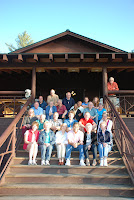 Twenty-two Elfuns from nine states recently put on their GE Volunteer caps for a week in mid-June at historic Ohana Camp in picturesque Vermont, accomplishing a wide range of volunteer tasks to help preserve the classic Vermont summer camp on the shores of Lake Fairlee.
Twenty-two Elfuns from nine states recently put on their GE Volunteer caps for a week in mid-June at historic Ohana Camp in picturesque Vermont, accomplishing a wide range of volunteer tasks to help preserve the classic Vermont summer camp on the shores of Lake Fairlee. 
Coming to Vermont from California to Connecticut, the Elfuns arrived on a Sunday evening and got the week started with a reception, dinner, and a look at three flip chart pages full of varied work assignments to be led by Ohana Camp Directors Andy and Deb Williams.
The list of accomplishments during the week was impressive! For example, Joe Gould and Randy Morrison built an enclosure for the goats, which sounds easy until calculating in the fact that posthole diggers are basically inoperative when hitting Vermont rock. But the posts are in and standing straight and tall, thanks to Joe and Randy, who also
 shored up the concrete foundation at the camp’s sugar house.
shored up the concrete foundation at the camp’s sugar house.Andy and Gary Sieving and Gisele Hill worked on both vegetable and flower garden beds, creating areas of both beauty and value. Kathleen Betchkal and Jean Jankowski teamed up to prep a building lovingly called “Area 51” to be the site of an urgently needed maintenance storage space.
 Carpentry par excellence produced a new deck for Cabin 12 thanks to Joe Maruyama, Bob McKenzie, and Gene Bratton, while nearby Otto and Moe Jankus and Al Jankowski put shingles on a staff cabin. Right behind them to paint the shingles were Joyce Maruyama and John Betchkal.
Carpentry par excellence produced a new deck for Cabin 12 thanks to Joe Maruyama, Bob McKenzie, and Gene Bratton, while nearby Otto and Moe Jankus and Al Jankowski put shingles on a staff cabin. Right behind them to paint the shingles were Joyce Maruyama and John Betchkal.Picasso-like painting of camp furniture badly in need of fresh coats of protective and appealing color was accomplished by Linda McKenzie, Carolyn Morrison, and Sue Sheridan. And they were neat – no spilled cans or brush marks!
Dave Hill and Richard Hoffard took charge of prepping the Gardenside building for staff housing, removing rafters which supported low ceilings, pulling out old wall board, checking electrical systems, and getting it spiffy “for immediate occupancy.”

Lois Lovinger was all smiles as she completed a star quilt which is beautiful and will have a place of honor. And our traveling Ohana Camp historian-in-residence-for-a-week, Jean Bratton, came up with more historical “finds”, adding to this locations wonderfully meaningful history.
It wasn’t all work for the week. Will Lange was here to deliver pure Vermont humor, Christopher Wren talked about “Walking to Vermont” following retirement from his NY Times desk , Ben Kilham amazed the group with his stories about bears in Vermont woods, and master storyteller Simon Brooks entertained us preceding a marvelous DVD presented by Andy Williams, summarizing our week together..
Best of all was the terrific hospitality, great food and sense of accomplishment we had during our week with Andy and Deb Williams and the wonderful Ohana Camp staff. Thanks, everybody, for the memories!





